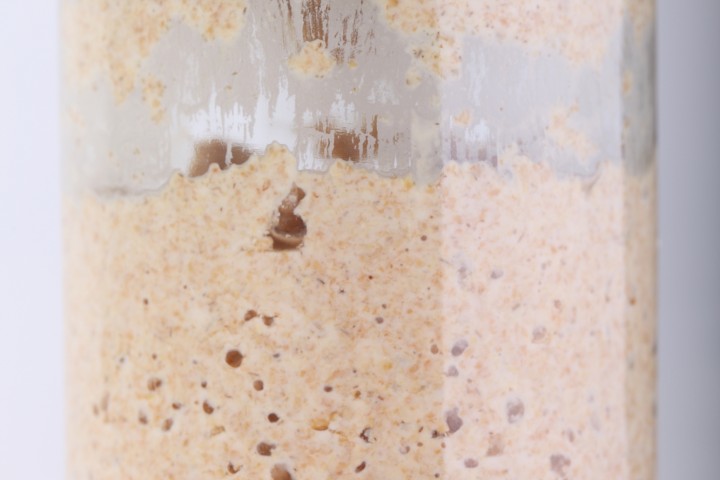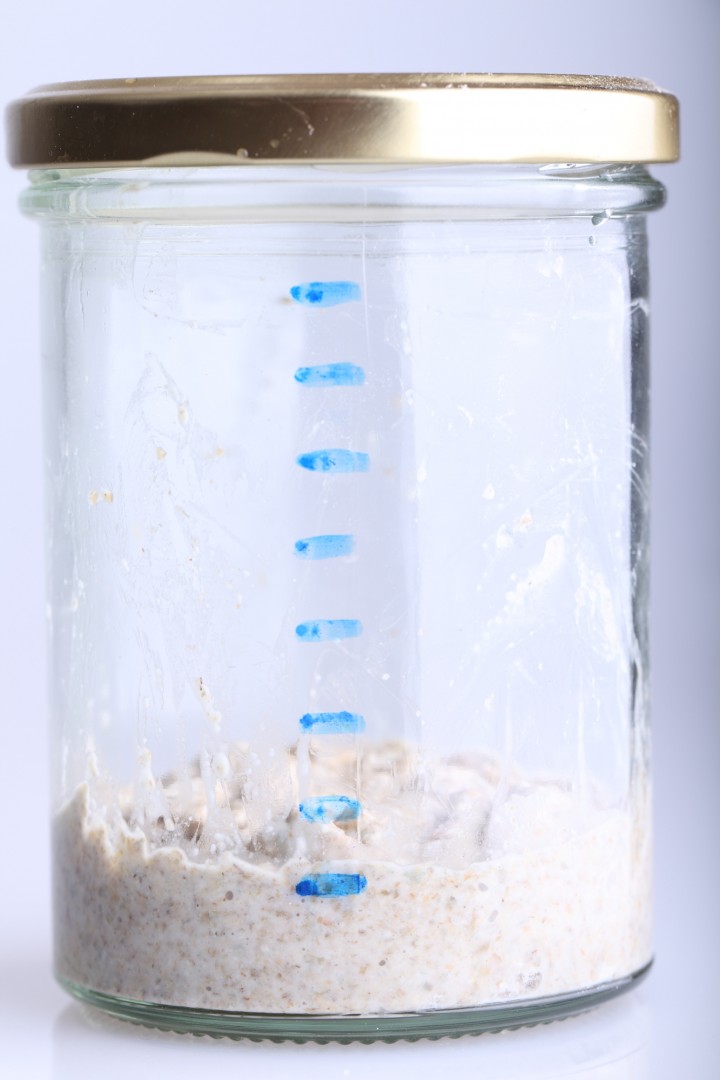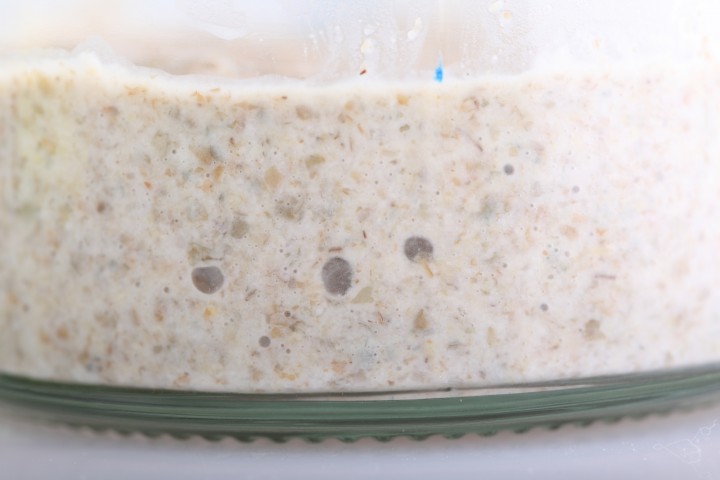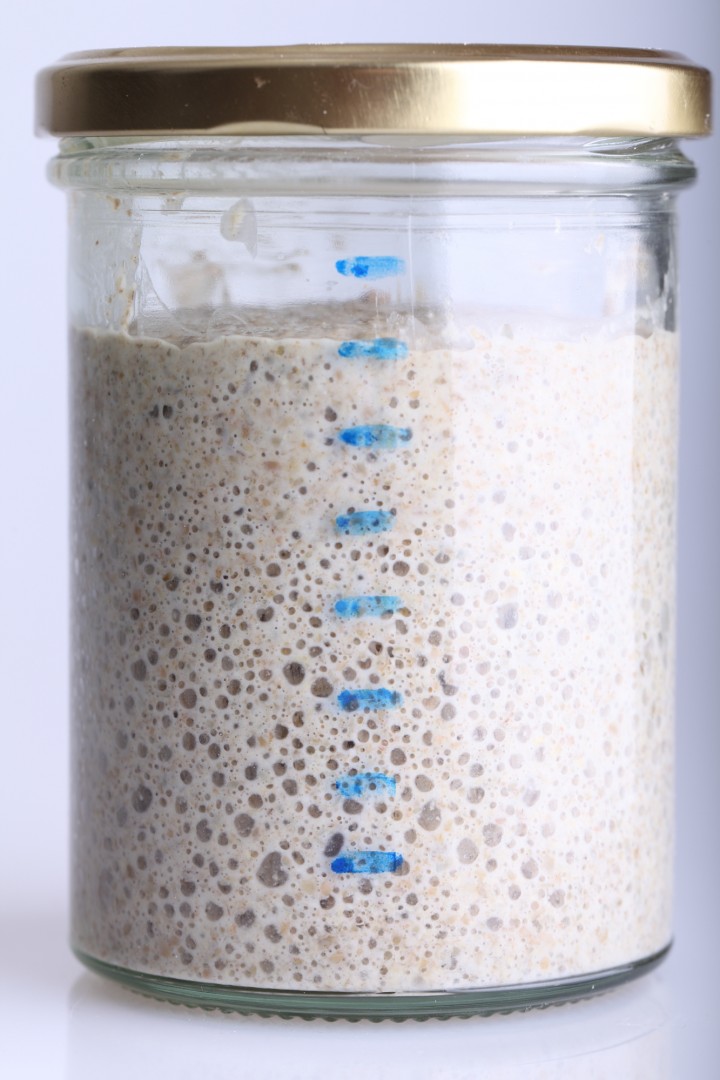Can You Use Sourdough Starter for Rye Bread

Our trusty, fruity rye sourdough starter civilisation
Nederlandse versie in de maak!
A lot has been written almost sourdough starter cultures. Yous can discover long and elaborate articles on how to make your own starter while using things like pineapple and grapes. They are near mythical creatures to be treated with the utmost care and fed every evening at the same time while standing on your caput. The truth is much simpler. My rye starter seems almost indestructible. And the merely thing I did is mix some whole grain rye flour with water and wait…
What is a starter?
A starter is a piece of dough which contains wild yeast and leaner which y'all apply to make your bread. The wild yeast produce carbon dioxide (and a fleck of alcohol as well) to brand your bread airy. It is the bacteria that can give your staff of life the sour gustatory modality, this is considering the bacteria transform the starch of the flour into lactic acid, acetic acid and alcohol. Both the acid and the alcohol requite sourdough bread their unique and interesting gustatory modality. You add an corporeality of your starter to a larger amount of flour and water mixture similar you normally utilise commercial yeast to a poolish or a biga preferment. It works only the same merely slower. Commercial yeasts are selected and bred for speed by the big yeast companies but wild yeast works at a slower pace. This is why staff of life recipes for sourdough breadstuff tend to have much longer and consist of more steps.
Why a rye starter civilization?
For my sourdough baking I apply a culture which is made with 100% whole rye flour. A sourdough culture based on rye flour is easier to maintain, it does non become into a slurry similar a wheat flour starter when you lot forget about information technology, it is easier to stir considering it has almost no gluten and it smells very very nice, a scrap similar fruit. Information technology is likewise very forgiving in the corporeality you feed information technology. Yous feed your culture after baking to replenish your stock. Normally I only feed it once a week, after my weekend blistering, I just give it a few table spoons of water and rye flour, stir and set!

The nativity of a new starter civilisation
Earlier starting your own culture
Start thing: work clean! Use a clean jar and e'er use clean spoons to stir and add flour to the mixture. The organisms living on your easily can contaminate your starter and spoil information technology! Throw away your starter and start over when it develops an awful scent or grows moldy in whichever color, it probably has picked up a bad bacteria in the start feeble stages of the starters life.
Later some enquiry I constitute that the nearly likely truth of the source of the yeast and bacteria is the flour itself. The yeast and bacteria live on the outside of the grain (just like the yeast to brand vino lives on the skin of the grapes). This is why you need (preferably organic) whole grain rye flour, because y'all need the outside bran of the grain every bit a source of yeast and bacteria.
I offset with a relative wet starter and when the starter is live add together more flour to maintain a more strong starter. I kickoff with a small amount of water and flour as non to waste too much flour, because you take to throw halve of the starter away with each refresh. When your starter is alive and kicking yous always can scale upwardly the size of your starter simply past adding more water and rye flour.
Be sure to use water which does not contain chlorine. Water companies sometimes add together a piffling chlorine to your tap water to kill all leaner and probably likewise the yeast in the water, and so it is not a good idea to apply this for building a sourdough starter. If in dubiousness you tin apply bottled water.
And now on with the easy steps!
Day 1: Take a small clean jar (I use a 400ml jam jar) and add 40ml of water and 40g of whole grain rye flour, stir with a clean spoon for 30 seconds. Draw a line to mark the height of the mixture with a permanent mark on the jar then y'all can see whatever activeness easily. Loosely close the lit of the jar and shop at room temperature (about 20-21 degrees Celcius) out of directly sunlight for 24 hours.
Stirring the mixture every 3 to 4 hours for 10 seconds helps distribute the flour, yeast and leaner and aerates the mixture which helps development.
Day 2: If you are lucky you should meet some little bubbles of air in the mixture. The smell of the mixture at this stage is not very nice, a chip musty but not totally off putting. Add 20ml of water and 20g of whole grain rye flour. Stir with a clean spoon for 30 seconds. Draw a new mark line if needed. Loosely close the lit of the jar and store at room temperature out of directly sunlight for 24 hours. Stirring the mixture 2 or 3 times a day for 10 seconds helps distribute the flour, yeast and leaner and aerates the mixture which helps evolution.

Some bubbling are visible afterward 24 hours – It's live, its live…
Day 3: Your mixture should now exist getting active. Mine did more than double in size during the concluding 24 hours. If your mixture is not very active however, throw away one-half of the mixture and repeat the directions of day 2 again. The olfactory property of your mixture should exist a little nicer at this stage. When your mixture is active, throw away ii third of the mixture and add 30ml of h2o and 30g of whole grain rye flour, stir with a clean spoon for thirty seconds and store at room temperature. Stir the mixture 2 or 3 times a mean solar day for ten seconds.
This is called refreshing or feeding your starter. By throwing out part of your mixture and calculation new rye flour you requite the starter fresh food (the rye flour) to work on, then all your new yeast and bacteria can get 'stronger' and multiply again. You also dilute the alcohol and the acrid they produce so the yeast and leaner do not 'toxicant' themselves.
Day 4: Your starter should now exist fully active and stiff enough to double or triple in size during a 24 hours time period. We need to refresh information technology again before we can employ this starter because the acrid producing bacteria need more fourth dimension to develop than the yeast. So throw away two third of the mixture and add together 30ml of water and 30g of whole grain rye flour, stir with a clean spoon for 30 seconds and store at room temperature.
When your starter is not active repeat the steps of mean solar day ii and iii until it is getting active. Sometimes it simply takes a few days longer, depending on flour, expanse and temperature. When at whatever stage your starter gets moldy, smells bad or you see colored spots on your starter which do not seem to belong there, y'all sadly accept to commencement over equally you probably picked upward some bad guests.

The starter is now 36 hours old and has doubled or tripled over the past 12 hours after feeding
Solar day 5: Your starter should at least double in size consistently after each refreshment to exist fix for your offset baking projection. If your culture does not double in size consistently after twenty-four hours four or 5 echo the directions of day 4 until it does.
At this stage your starter should be developing a nice fruity smell during the side by side few days. You lot can now let your starter rest for a few days. After refreshing, I keep my starter on the counter for 12 to 24 hours, look for it to double in size and develop and then store it in the refrigerator. Mine developed a nice fruity tone on twenty-four hour period half-dozen which got even nicer on day 7. Just go on using and maintaining the starter from now on, after a while the color of your starter should get a fiddling scrap more beige after it has doubled or tripled later a feeding (notice the divergence in color of my erstwhile and new starter). This is a sign of maturation of the starter and the production of acrid.
How to maintain your starter
A rye starter does not need much maintenance. We store our starter in the fridge. We bake (almost) every weekend so our starter is existence refreshed at to the lowest degree each week. We keep about 120g of starter of which we use about 60g up to 100g each week. So afterward taking out the amount for blistering, we simply add water and rye flour and stir, and then we have nigh 120g of starter over again. We proceed our starter quite strong, well-nigh similar a thick paste. The reason for this is that it will develop a lot slower with less h2o, so it matures during the week and is ready for baking the next weekend.
After feeding we keep the starter on the kitchen table at room temperature (normally around 21C) for about 12 hours so it can develop and double or triple in size. When it has developed, nosotros store it in the fridge until the next baking session. Always wait for your starter to at least double in size before storing it in the fridge, a starter should exist fully adult earlier it tin survive in the cold. A starter kept in the refrigerator should at to the lowest degree be refreshed every two weeks. A starter kept on your counter should be refreshed at least every 3 days.
If we want to bake, nosotros take it out of our fridge and use it directly for a poolish or biga. Then refresh it, and so it will be prepare and active for our next blistering session. That's it!
Small video clip timelaps of ascension of rye sourdough starter
More than sourdough tips to help you broil that perfect sourdough loaf! Plus some recipe suggestions.
murillowastumpaboos.blogspot.com
Source: https://www.weekendbakery.com/posts/rye-sourdough-starter-in-easy-steps/
0 Response to "Can You Use Sourdough Starter for Rye Bread"
Post a Comment